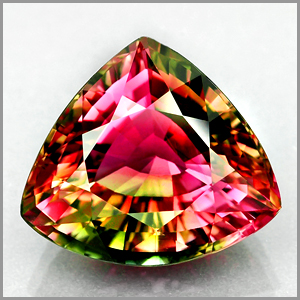The name means to see a change of color; opals have an unusual optical effect of shifting spectral hues described as play of color. The birthstone for October, opal is revered as a symbol of hope, fidelity and purity and reveals the colorful attributes of those who wear it.
Opals are a chameleon of stones, encompassing the essence of every gemstone in one and date back to prehistoric times.
Opals are described according to their transparency and body color. While experts divide gem opals into many different categories, the main types (according to the American Gem Trade Association) are:
- White opal – translucent to semi-translucent with play-of-color against a white or light gray body color.
- Black opal – translucent to opaque with play-of-color against a black or other dark body color.
- Fire Opal – transparent to translucent with brown, yellow, orange, or red body color. This material, which often does not show play-of-color, is also known as “Mexican opal,” “gold opal,” or “sun opal.”
Play-of-color occurs because opal is made up of sub-microscopic spheres stacked in a grid-like pattern, like layers of ping-pong balls in a box. This structure breaks up light into spectral colors. The colors you see depend on the sizes of the spheres. Opal is a non-crystallized silica, which is a mineral found near the earth’s surface in areas where ancient geothermal hot springs once existed. As the hot springs dried up, layers of the silica, combined with water, were deposited into the cracks and cavities of the bedrock, forming Opal.

Opal Peacock Brooch on display at the Smithsonian
Because opal contains varying amounts of water, it is a soft stone and if exposed to changes in heat and pressure, the appearance can change. When water evaporates out of an opal, the stone can appear to be slightly smaller and the stress
Opal is a soft stone, easily altered in appearance by changes in heat and pressure. This mineral contains varying amounts of water within it that determine the appearance of the gemstone. When water evaporates out of an opal, the stone appears slightly smaller and the stress of the evaporation creates cracks on it.
Folklore:
Prized for its unique ability to refract and reflect specific wavelengths of light, the Opal was also called “Cupid Paederos” by the Romans, meaning a child beautiful as love.
Arabic legends say it falls from the heavens in flashes of lightning. The ancient Greeks believed opals gave their owners the gift of prophecy and guarded them from disease. Europeans have long considered the gem a symbol of hope, purity, and truth.
Some people think it’s unlucky for anyone born in another month to wear an opal, but that particular superstition comes from a novel written in the 1800s (Anne of Geierstein by Sir Walter Scott) and not from ancient belief or experience. In fact, throughout most of history, opal has been regarded as the luckiest and most magical of all gems because it can show all colors. Once, it was thought to have the power to preserve the life and color of blond hair.






